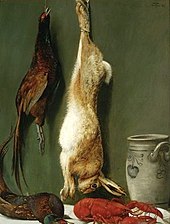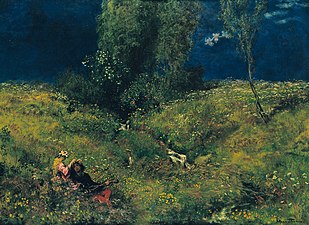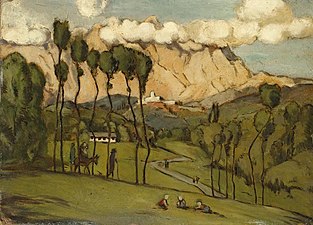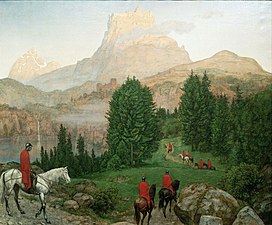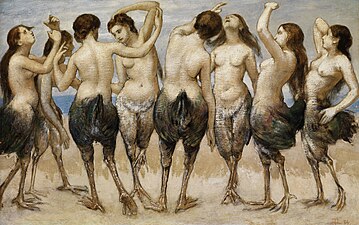Hans Thoma
This article may require cleanup to meet Wikipedia's quality standards. The specific problem is: WP:NOTGALLERY reduce excessive number of images. (February 2023) |
You can help expand this article with text translated from the corresponding article in German. (December 2021) Click [show] for important translation instructions.
|
Hans Thoma | |
|---|---|
 | |
| Born | 2 October 1839 |
| Died | 7 November 1924 Karlsruhe |
| Occupation | Painter, printmaker, graphic artist |
| Spouse(s) | Cella Thoma |

Hans Thoma (2 October 1839 – 7 November 1924) was a German painter.
Biography[edit]
Hans Thoma was born on 2 October 1839 in Bernau, Grand Duchy of Baden, in the Black Forest, Germany.[1] He was the son of a miller and was trained in the basics of painting by a painter of clock faces.[1] He entered the Karlsruhe Academy in 1859, where he studied under Johann Wilhelm Schirmer and Ludwig des Coudres – the latter of which had a major influence on his career.[2] Thoma also studied under Hans Gude, but rebelled against Gude's realism.[3] He subsequently studied and worked, with but indifferent success, in Düsseldorf, Paris, Italy, Munich and Frankfurt, until his reputation became firmly established as the result of an exhibition of some thirty of his paintings in Munich.[4] He died in Karlsruhe in 1924 at the age of 85.
Style[edit]
In spite of his studies under various masters, his art has little in common with modern ideas, and is formed partly by his early impressions of the simple idyllic life of his native district, partly by his sympathy with the early German masters, particularly with Albrecht Altdorfer and Lucas Cranach the Elder. In his love of the details of nature, in his precise drawing of outline, and in his predilection for local coloring, he has distinct affinities with the Pre-Raphaelites.[4]
Works[edit]
Many of his pictures have found their way into two private collections in Liverpool. A portrait of the artist and two subject pictures, The Guardian of the Valley and Spring Idyll are at the Galerie Neue Meister; Eve in Paradise and The Open Valley at the Städel. Other important pictures of his are Paradise, Christ and Nicodemus, The Flight into Egypt, Charon, Pietà, Adam and Eve, Solitude, Tritons, besides many landscapes and portraits.[4]
He also produced numerous lithographs and pen drawings, and some decorative mural paintings, notably in a café at Frankfurt, and in the music room of the Alfred Pringsheim house in Munich.[4]
Thoma's artwork was favored by Nazis during the Third Reich 1933-1945 and he was listed among official painters.[5] Artworks acquired for Adolf Hitler's planned Führermuseum in Linz included Badende Jünglinge (bathing boys), looted from the Jewish collector Adolf Bensinger in 1939,[6] and Blick auf Mamolsheim, looted from the Jewish collectors Martin and Florence Flersheim.[7] Other artworks by Thoma that were acquired during the Nazi era from Jewish collectors include "Dusk at Lake Garda", looted from the Jewish collector Ottmar Strauss,[8] "Springtime in the Mountains/Children’s Dance," sold under duress in 1938 by Hedwig Ullmann,[9] Sinnendes Mädchen / Frau mit Schimmel (‘Pensive Girl/Women with White Horse’) (Lost Art-ID 302432) looted from the Jewish art collector Smoschewer in 1939[10] and The Rhine at Säckingen in the Black Forest formerly owned by Max Emden.[11] The German Lost Art Database lists several paintings by Thoma.[12]
- Late Summer Day in the Black Forest
- The Rhine Near Seackingen
- Sunday Peace
- Still life with a hare, pheasants and a lobster
- Diana under the tree
- Portrait of Conrad Fiedler
- The Haag Daughters
- Summer
- The Mountains of Carrara
- The Gralsburg
- Landscape
- View of Mamolsheim
- Temptation on the Mount
- Children with a Herd of Goats
- Eight Dancing Maidens in Bird Costumes
- December
- June
- Self-Portrait with Flower
References[edit]
- ^ a b "Thoma, Hans". Benezit Dictionary of Artists. 31 October 2011. doi:10.1093/benz/9780199773787.article.B00181989. ISBN 978-0-19-977378-7. Retrieved 16 November 2019.
- ^ Ruhmer, Eberhard (2003). "Thoma, Hans". Grove Art Online. doi:10.1093/gao/9781884446054.article.T084604. ISBN 978-1-884446-05-4. Retrieved 16 November 2019.
- ^ Bjerke, Øivind (15 June 2016). "Hans Gude – En kunstnerreise" [Hans Gude. An artist’s journey]. Romantik. 5 (1): 136. doi:10.7146/rom.v5i1.26428. Archived from the original on 9 August 2023. Retrieved 8 August 2023.
His [Gude's] most famous German pupil, Hans Thoma, however, was a great admirer of Courbet and challenged Gude's timid realism and harmonizing art.
- ^ a b c d One or more of the preceding sentences incorporates text from a publication now in the public domain: Chisholm, Hugh, ed. (1911). "Thoma, Hans". Encyclopædia Britannica. Vol. 26 (11th ed.). Cambridge University Press. p. 862.
- ^ "Hans Thoma: Hitler's Favorite Artist?". Big Think. Retrieved 5 February 2023.
- ^ "(#20) Hans Thoma". 5 February 2023. Archived from the original on 5 February 2023. Retrieved 5 February 2023.
Provenance Adolf Bensinger, Mannheim (acquired circa 1902-1909) Confiscated by the Oberfinanzpräsident Baden in 1939 Forced sale of the Estate of Adolf Bensinger, Nagel, Mannheim, 22 February 1940, lot 53 Galerie Zinckgraf, Munich (acquired at the above sale) Acquired from the above by the German Reich for the proposed Führermuseum, Linz Central Collecting Point, Munich Federal Republic of Germany (as successor to the above; unknown owner property) Kaiser Wilhelm Museum, Krefeld (on permanent loan from the Federal Republic) Restituted to the heirs of Adolf Bensinger in 2011
- ^ "Christie's LIVE AUCTION 7888 OLD MASTER & 19TH CENTURY PAINTINGS, DRAWINGS & WATERCOLOURS (DAY SALE) LOT 319 PROPERTY FROM THE MARTIN AND FLORENCE FLERSHEIM COLLECTION Hans Thoma (German, 1839-1924) Blick auf Mamolsheim". Archived from the original on 5 February 2023.
- ^ "05.10.2004 RESTITUTION OF A PAINTING BY HANS THOMA" (PDF). Pinakothek.
The painting "Dusk at Lake Garda", 1906 by Hans Thoma has been restituted by the Bayerische Staatsgemäldesammlungen to the heirs of the picture's former Jewish owner. General Director Reinhold Baumstark handed over the painting to Dr. Jost von Trott zu Solz, representative of Ottmar Strauss, to whom the picture once belonged.
- ^ JTA. "German family firm to return Nazi-looted artwork to Jewish heirs". www.timesofisrael.com. Retrieved 5 February 2023.
- ^ "German Lost Art Foundation - News - From lost art research to restitution: how a painting from the Smoschewer Collection found its way to the heirs". www.kulturgutverluste.de. Retrieved 5 February 2023.
- ^ "Sotheby's HANS THOMA | The Rhine at Säckingen in the Black Forest". Sotheby's. Archived from the original on 5 February 2023.
Provenance Felix Herrmann, Berlin (by 1909) Paul Rauers, Munich (by 1919 and until at least 1922) Dr Max Emden, Hamburg (1874-1940. The son of a wealthy merchant, Max Emden was a renowned textile trader who expanded his company within a successful franchising model supplying stores all over Germany. Despite his status as a converted Jew and a protestant Swiss citizen, Max Emden was subject to racial persecution and was the target of Nazi compulsory confiscation of his assets which led him to insolvency and to the forced sale of part of his art collection. His son and sole heir, Hans Erich Emden, was stripped of German citizenship in May of 1940 and forced to flee to South America.) Fritz and Peter Nathan, Zurich; thence by descent to the present owner
- ^ "Suche | Lost Art-Datenbank". www.lostart.de. Retrieved 5 February 2023.
External links[edit]
- German masters of the nineteenth century: paintings and drawings from the Federal Republic of Germany, a full text exhibition catalog from The Metropolitan Museum of Art, which contains material on Hans Thoma (nos. 91–95)


 French
French Deutsch
Deutsch


